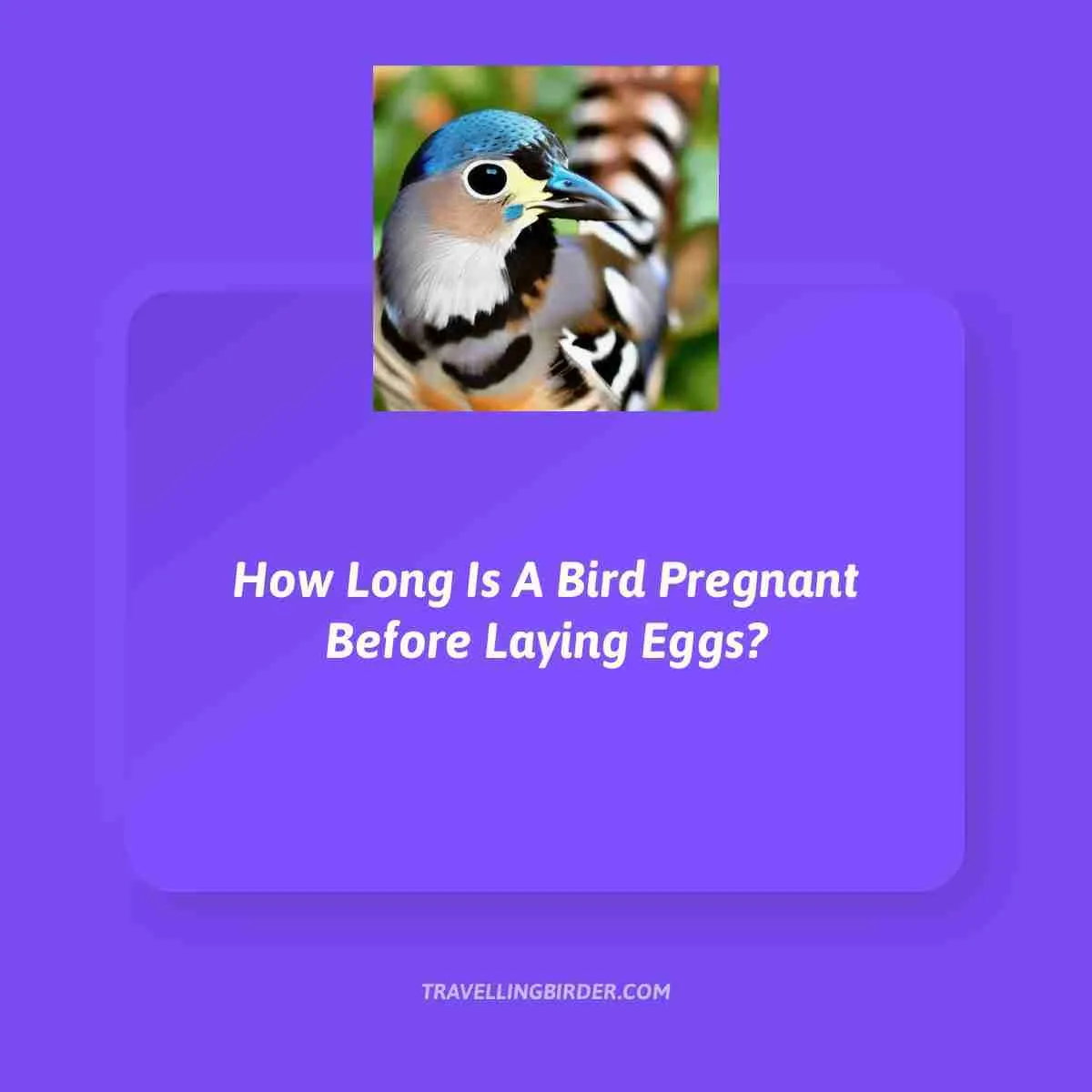Bird lovers and backyard birdwatchers often marvel at the miracle of life unfolding before their eyes. Whether it’s a robin nesting in your tree or sparrows visiting your feeder, you may find yourself wondering just how long these feathered friends are pregnant before they lay their eggs.
The process is fascinating, and understanding more about it can help us appreciate the incredible journey that birds go through to bring new life into the world.
It’s important to note that birds don’t experience pregnancy like mammals do; instead, they produce eggs which then develop outside their bodies. So, technically speaking, we won’t be discussing ‘pregnancy’ as such – but rather how long it takes for them to create those precious little packages filled with future hatchlings.
Dive in with us as we explore what goes on behind the scenes in avian reproduction and learn all about the delicate dance between egg production and laying!
The Process Of Egg Production In Birds
As the saying goes, ‘you can’t make an omelette without breaking eggs,’ and similarly, understanding the process of egg production in birds is essential to comprehending avian reproduction.
Birds go through a unique reproductive system that involves internal fertilization followed by external incubation of their eggs.
Once egg fertilization occurs within the female bird’s body, it takes some time for the development of the embryo and formation of the hard shell before she lays her egg(s).
The entire process from fertilization to laying eggs varies among species and depends on several factors such as size, habitat, and overall health condition of individual birds.
With this foundation laid out, let us delve into what influences these various aspects of bird pregnancy and how they contribute to shaping each species’ distinct approach to reproducing life.
Factors Influencing Egg Development
Temperature can have a big impact on the development of eggs, so it’s important to make sure that the conditions are right.
Nutrition plays a role too, so the parents should provide a balanced diet to the growing eggs.
Finally, parental care is key; they need to keep the eggs safe and warm to ensure successful development.
Temperature
Temperature plays a significant role in the development of bird eggs, as climate impact and seasonal patterns can directly influence how long a bird is pregnant before laying eggs.
Birds living in colder climates may slow down their reproductive cycles to conserve energy or time their egg-laying with warmer periods when food sources are more abundant.
These temperature fluctuations often result in variations among species and even individuals within a species.
In contrast, birds living in stable tropical climates may have less variation in pregnancy length due to consistent temperatures and available resources throughout the year.
Ultimately, understanding these factors better allows us to appreciate the intricacies present within avian reproduction across various environments.
Nutrition
In addition to temperature, another crucial factor influencing egg development in birds is their nutrition.
A bird’s nutritional requirements play a significant role in determining the quality and quantity of eggs produced, as well as the overall health of both parent birds and their offspring.
The dietary impact on avian reproduction varies depending on species-specific needs and local food availability.
For example, some birds may require more protein or calcium during breeding season for proper egg formation, while others might need additional energy from carbohydrates to support increased metabolic demands associated with incubation and nestling care.
As we continue exploring factors that affect bird egg development, it’s essential to consider how different aspects of a bird’s diet contribute to successful reproduction efforts across diverse environments.
Parental Care
In light of the significance of nutrition in egg development, it’s worth noting that parental care also plays a vital role in avian reproduction.
After all, birds have to invest time and energy into protecting their eggs, maintaining an optimal temperature for incubation, and feeding their young once they hatch.
One fascinating aspect of bird parenting is the phenomenon of brood parasites – species like cuckoos who lay their eggs in other birds’ nests, essentially outsourcing parental duties to unsuspecting hosts.
This strategy allows brood parasites to save resources by avoiding the costs associated with raising offspring themselves.
On the other hand, clutch size can vary greatly among different bird species depending on factors such as predation risk and food availability; larger clutches may be advantageous when conditions are favorable while smaller ones might prove less taxing on parents struggling to provide enough nourishment during challenging times.
Thus, understanding how various forms of parental care impact egg development further enriches our knowledge about this intricate facet of avian life.
Timeframes For Different Bird Species
The duration of bird fertility and the time it takes for eggs to be laid varies significantly among different species. Some factors that contribute to these variations include environmental conditions, food availability, and individual reproductive strategies.
Hatching variations are also common among birds, with some species having synchronized hatching while others have asynchronous hatching patterns.
- Synchronized hatching:
In this pattern, all eggs in a clutch hatch within a short period (usually 24 hours), ensuring that chicks compete on an equal footing.
Examples: songbirds such as robins or blue tits - Asynchronous hatching:
This pattern results in staggered hatching dates where younger siblings may be at a disadvantage competing for resources.
Examples: raptors like eagles or owls
Understanding the intricacies of each bird’s unique timeframe is essential when studying their nesting and egg-laying behavior. With this knowledge, we can now delve deeper into the complexities of avian reproduction processes.
Nesting And Egg-Laying Behavior
It may come as a surprise to learn that birds are not technically ‘pregnant’ in the way mammals are; instead, they lay eggs shortly after fertilization occurs.
The time between mating and egg-laying varies among different bird species but is generally quite short – for example, it can be as little as 24 hours in some passerine (perching) birds.
Nesting and egg-laying behavior play crucial roles in avian reproduction, with many species investing significant time and energy into creating elaborate nests to protect their offspring from nest predators.
As part of this process, both male and female birds often engage in complex courtship rituals or displays to attract a mate and secure the best nesting sites possible.
With all these fascinating aspects at work during this critical stage of reproduction, it’s clear that there’s much more to explore when it comes to understanding how our feathered friends bring new life into the world.
Next on our journey through avian reproductive processes will be examining how various types of birds care for their eggs during incubation periods.
Caring For Eggs And Incubation Periods
As we delve deeper into the world of nesting and egg-laying behavior, it is essential to consider how bird parents care for their eggs and master incubation techniques.
Egg care tips vary depending on the species; however, some general practices include properly positioning the eggs in the nest, maintaining a clean environment, and ensuring that both parents participate in keeping the eggs warm through consistent incubation.
Incubation periods also differ among birds, with some lasting only a couple of weeks while others may extend up to several months.
During this time, parent birds must be diligent in providing warmth and protection from predators to ensure successful hatching of their offspring.
Frequently Asked Questions
Can Birds Lay Eggs Without Being Pregnant Or Mating With A Partner?
Imagine a delicate dance of nature, where the sky is painted with wings and feathers as birds soar through the air.
In this ballet, egg development plays a crucial role in creating new life.
Interestingly enough, some birds can lay eggs without being pregnant or even mating with a partner.
These infertile eggs are products of an act that appears to defy the very essence of reproduction itself.
Yet for those who bear witness to it, there remains a sense of wonder – how these remarkable creatures continue to bring forth their fragile treasures into the world despite not having experienced the union between two partners typically associated with procreation.
What Are Some Common Signs That A Bird Is About To Lay An Egg?
Some common signs that a bird is about to lay an egg include exhibiting nesting behaviors and displaying egg bound symptoms.
Nesting behaviors may involve the bird gathering materials, such as twigs or feathers, to create a comfortable space for laying eggs. They might also become more territorial and protective of their chosen nesting area.
Egg bound symptoms, on the other hand, can indicate complications in the egg-laying process. These may include loss of appetite, lethargy, difficulty passing droppings, and straining or discomfort while trying to lay the egg.
It’s important to monitor your bird closely if you suspect they’re about to lay an egg and consult with a veterinarian if any concerns arise during this time.
Are There Any Health Risks Or Complications Associated With Egg-Laying In Birds?
Surprisingly, about 12% of pet birds experience egg-laying related complications, which can pose serious health risks.
One common issue is egg binding, a condition where a bird has difficulty or is unable to pass an egg due to various factors such as poor muscle tone, obesity, or inadequate calcium levels.
Proper avian nutrition plays a crucial role in preventing these complications; for instance, ensuring your bird receives adequate calcium and vitamin D3 can support healthy egg formation and shell quality.
It’s essential for bird owners to be aware of the possible health risks associated with egg-laying and provide their feathered friends with proper care and diet to minimize potential problems.
How Do Environmental Factors, Such As Temperature And Daylight Hours, Affect Egg-Laying In Birds?
Environmental factors, such as temperature and daylight hours, significantly impact egg-laying in birds due to their influence on breeding behavior and physiology.
Climate impacts, including fluctuations in temperature and seasonal changes, can affect the timing of reproduction by altering food availability, migratory patterns, and nesting conditions.
For instance, longer daylight hours during spring often stimulate hormonal responses that trigger breeding activity in many bird species.
Additionally, warmer temperatures may accelerate insect population growth, providing an abundant food source for both parent birds and their offspring.
Consequently, understanding the complex relationship between environmental factors and avian reproductive cycles is essential for predicting potential effects of climate change on bird populations worldwide.
Can Birds Of Different Species Mate And Produce Hybrid Offspring Through Egg-Laying?
Surprisingly, birds of different species can indeed mate and produce hybrid offspring through egg-laying, resulting in fascinating combinations of characteristics.
These hybrids often exhibit unique plumage patterns and intriguing behaviors that blend aspects from both parent species.
While it’s not common for such cross-species mating to occur in the wild, certain factors like habitat overlap or limited availability of mates within a single species may increase its likelihood.
However, keep in mind that these captivating hybrids are typically less fertile than their purebred counterparts and might face challenges integrating into either parental population due to their distinctive traits.
What Are the Signs of a Dying Bird?
The telling signs of a dying baby bird may include a fluffed up appearance, weak or labored breathing, inability to perch or fly, discolored or crusty feathers, and a lack of appetite. It’s important to seek immediate help from a wildlife rehabilitator if you come across a vulnerable bird displaying these symptoms.
Conclusion
So, you see, our lovely feathered friends don’t quite experience pregnancy like us humans do. They’re too busy flaunting their beautiful plumage and mastering the art of tweet-tweeting to bother with such mundane matters.
Next time you spot a bird proudly perching on its egg-filled nest, just remember that they’ve got it all figured out in their own quirky way.
No need for baby showers or prenatal yoga classes – these avian wonders know how to lay down some serious family planning skills.

An avid ornithologist, zoologist and biologist with an unwavering passion for birds and wild animals.
Dr. Wilson’s journey in ornithology began in childhood and led him to obtain a Ph.D. in Ornithology from the prestigious Avian Research Institute. He has worked closely with renowned experts in the field and conducted extensive research and field studies globally.




